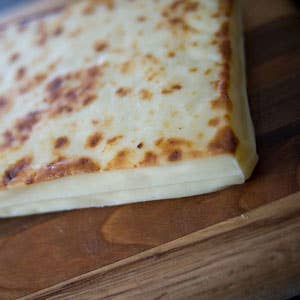
Five Great Wisconsin Cheeses You’ve Never Heard of…Plus a Limburger.
Here is a repertoire of six lovely but little-known varieties of Wisconsin cheese.
Mention Wisconsin cheese, and most people picture generic, oversize blocks of commodity swiss, cheddar, and muenster—utilitarian chunks that are mild (some would say flavorless) and good for shredding, melting, and little else. In recent years, however, increasing competition from California (the state that is now on schedule to outproduce Wisconsin in terms of sheer volume of cheese) has prompted the dairymen of America's heartland to embrace a wider variety of cheese styles and artisanal techniques. The result is an American cheese renaissance led by a repertoire of lovely but little-known varieties. Here are six worth seeking out.
When the bosses at BelGioioso are away in Italy, the cheese makers at the company's Wisconsin plants take the opportunity to test out new ideas. Their creamy, mellow Crescenza-Stracchino is the outcome of just one such clandestine cheese-making venture.
According to master cheese maker Gianni Tofolon Tofolon, Crescenza-Stracchino is based on a seasonal cheese from northern Italy. (The name is a reference to the stracca, or tired, cows that travel up and down the mountains.) The texture is almost liquid, and the taste combines the pungency of fresh buttermilk with the lusciousness of mild brie. The cheese is excellent spread on a delicate slice of baguette or smeared on a ham sandwich.
In contrast to the stiff, dry texture and santitized flavor of conventional string cheese, the version made by David Metzig at Union Star is moist and flavorful, as if it were milk made solid. Each fat, spaghetti-like strand is a piece of pure dairy essence, both satisfyingly salty and surprisingly tender.
Master cheese maker Bob Wills of Cedar Grove produces a number of "originals"—cheeses you can't find elsewhere else in Wisconsin; one of the most interesting is aged Faarko, a Danish-style cheese made from cows' and sheep's milk. The aged version is smooth, buttery, and almost fruity, with an afternote of cherry.
The SarVecchio made by Sartori Foods (formerly known as Stravecchio from Wisantigo cheese; that company was recently acquired by the family-owned brand Sartori Foods) is a delightful aged cheese in the style of parmesan. Slightly crumbly, without being acidic or overpowering, it combines a salty flavor with a nice, creamy finish.
Like a Cypriot halloumi or an Indian paneer, this Finnish "bread cheese" doesn't melt when it's heated. Though it has a mild flavor and a pleasantly soft texture that is reminiscent of mozzarella's, Juustoleipa's salty kick sets it apart. The outside of the cheese, which is slightly browned from being broiled during production, retains a nutty taste that is delicious. Production of Juustoleipa has boomed in recent years, with makers such as Carr Valley expanding their distribution throughout Wisconsin and beyond the state borders.
The "haute" potential of this washed-rind cheese is strong but little tapped. Yes, at a certain age it does begin to smell...well, like feet, but what's rarely acknowledged about limburger is the complexity of its life cycle. As it ages, the bacteria in the cheese consume its proteins and convert them to ammonia, making it progressively softer and more odoriferous. At one to two months, limburger has the crumbly, chalky freshness of feta; at three to four months, it grows softer and more flavorful, like a brie or a camembert; and only at five to six months does it slump into the gooey, rank condition for which it has become notorious.
Myron Olson at Chalet Co-Op (the last maker of limburger in North America) reports that one Chicago restaurateur recently put "limburger dumplings" on her menu. They were a flop. In desperation, she changed the name to "dumplings with surface-ripened cheese". She sold a boatload. Sometimes image is key.
James Norton and Becca Dilley are the authors of the forthcoming book The Master Cheesemakers of Wisconsin (University of Wisconsin Press, 2009), which details the lives, times, and cheeses of more than 40 of the state's best cheese makers. For more information on their book go to www.mastercheesemakerbook.com.
Keep Reading
Continue to Next Story










